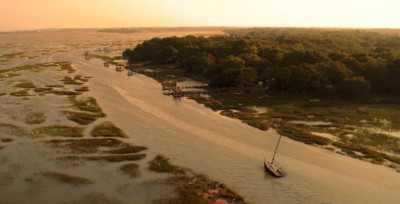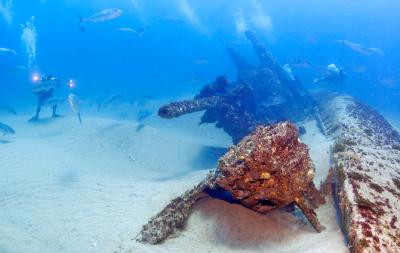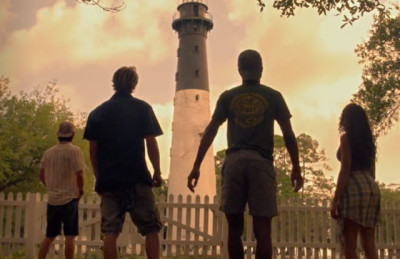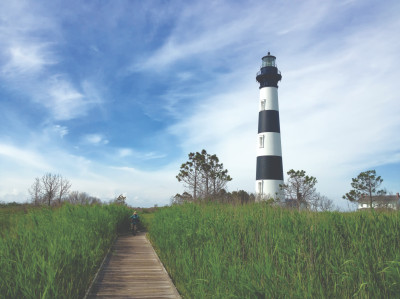The Netflix series “Outer Banks” has captivated audiences worldwide with its thrilling treasure hunts, teen drama, and stunning coastal backdrops. Fans are drawn into the world of the Pogues and Kooks, set against the mysterious and beautiful “Outer Banks.” But for those wondering if they can visit these sandy shores and explore the real-life locations, the burning question arises: Where Does Outer Banks Take Place?
While the show is set in the Outer Banks of North Carolina, a chain of barrier islands brimming with history and natural beauty, it’s important to note that filming primarily occurred in a different location. Let’s dive into the fascinating details of the show’s setting and the real-world inspiration behind it.
The Fictional Kildare County vs. The Real Dare County, North Carolina
In “Outer Banks,” the story unfolds in the fictional Kildare County. This name might sound familiar to those acquainted with the region, and that’s no coincidence. Kildare is cleverly crafted as a blend of Dare County, North Carolina – the actual county encompassing a significant portion of the Outer Banks – and Kill Devil Hills, a prominent town within Dare County. This fictional county serves as the backdrop for the social divide between the wealthy Kooks and working-class Pogues as they navigate life, love, and legendary treasure.
However, while the series draws heavily from the spirit and lore of the Outer Banks, North Carolina, the cameras rolled elsewhere for much of the filming. The primary filming location for “Outer Banks” is actually Charleston, South Carolina. This charming Southern city and its surrounding areas provided the production team with the necessary infrastructure and diverse landscapes to bring the Outer Banks to life on screen.
 Outer Banks Netflix Show Welcome Sign
Outer Banks Netflix Show Welcome Sign
Sign welcoming visitors to the fictional “Outer Banks” as depicted in the Netflix show.
 Welcome to Outer Banks Sign
Welcome to Outer Banks Sign
A real welcome sign for the Outer Banks in Manteo, North Carolina, showcasing the authentic location that inspired the series.
Exploring the Real-World Inspirations Behind Outer Banks
Despite being filmed primarily in South Carolina, the essence of the Outer Banks, North Carolina, permeates the Netflix show. The writers have skillfully woven in elements of the region’s unique character, history, and geography to create an authentic atmosphere.
Coastal Setting and Lifestyle
The show accurately portrays the Outer Banks as a coastal community deeply intertwined with the ocean. The depiction of waterfront boardwalks, marinas bustling with activity, and a thriving tourism scene reflects the reality of towns like those found in the Outer Banks. Just like in the series, you can explore charming local shops offering coastal art, jewelry, and unique gifts, and enjoy outdoor dining experiences with fresh seafood.
Beyond the tourism facade, the show also hints at the deep-rooted commercial fishing heritage of the Outer Banks. For generations, families have relied on the waters for their livelihoods, providing fresh catches to local restaurants and markets, a tradition that continues to this day.
 Nags Head Fishing Pier in the Outer Banks of North Carolina
Nags Head Fishing Pier in the Outer Banks of North Carolina
The fictional coastal dining ambiance in “Outer Banks” mirrors the real waterfront dining and pier experiences available, such as this scene at Nags Head Pier.
Shipwrecks and the Graveyard of the Atlantic
The treasure hunt in “Outer Banks” is sparked by a shipwreck, a theme deeply resonant with the real history of the Outer Banks. Known as the “Graveyard of the Atlantic,” this coastline has witnessed thousands of shipwrecks over centuries due to treacherous currents, storms, and shifting sandbars. Estimates suggest nearly 3,000 vessels rest beneath the waves off the Outer Banks.
While the show’s shipwreck is fictional, the real Outer Banks offers tangible connections to this maritime history. Shipwrecks are occasionally uncovered on the beaches, and the area is renowned for snorkeling and scuba diving, allowing enthusiasts to explore underwater wreck sites teeming with marine life. Locations like Kill Devil Hills and Nags Head offer accessible wreck dives, and for experienced divers, deeper excursions reveal German U-boats from World War II.
 Outer Banks Show Shipwreck
Outer Banks Show Shipwreck
A dramatic shipwreck scene from “Outer Banks,” reflecting the region’s rich maritime history.
 Graveyard of the Atlantic Scuba Diving Shipwreck In The Outer Banks Of North Carolina
Graveyard of the Atlantic Scuba Diving Shipwreck In The Outer Banks Of North Carolina
Scuba divers explore a real shipwreck in the Graveyard of the Atlantic, offering a tangible connection to the show’s themes.
Lighthouses – Beacons of the Coast
Lighthouses play a symbolic role in “Outer Banks,” with the fictional Redfield Lighthouse serving as a crucial location. In reality, the Outer Banks boasts several iconic lighthouses that are not only navigational aids but also beloved landmarks.
The Cape Hatteras Lighthouse, the tallest brick lighthouse in North America, stands as a globally recognized symbol of the Outer Banks. Bodie Island Lighthouse in Nags Head, with its striking black and white stripes, has been guiding mariners for over a century. Even newer additions like the Roanoke Marshes Lighthouse on the Manteo waterfront, a replica of a historic screwpile lighthouse, contribute to the region’s rich maritime character.
 Outer Banks Show Lighthouse
Outer Banks Show Lighthouse
The fictional Redfield Lighthouse from “Outer Banks,” a nod to the real lighthouses of the region.
 Bodie Island Lighthouse in Nags Head In The Outer Banks Of North Carolina
Bodie Island Lighthouse in Nags Head In The Outer Banks Of North Carolina
The real Bodie Island Lighthouse in Nags Head, a beacon that inspires the coastal atmosphere of the show.
Ferries – Fact vs. Fiction
While “Outer Banks” might depict a ferry route between the OBX and Chapel Hill (inland NC), the reality is slightly different. Ferries are indeed an integral part of transportation in the Outer Banks, primarily for accessing Ocracoke Island, the southernmost inhabited island in the chain.
The Hatteras to Ocracoke Ferry offers a scenic and free passage, allowing visitors to explore the unique charm of Ocracoke. Bridges and ferries connect the main islands of the Outer Banks, making island hopping a popular activity for tourists.
 Hatters Island to Ocracoke Ferry
Hatters Island to Ocracoke Ferry
The Hatteras to Ocracoke Ferry, a real mode of transport in the Outer Banks, contrasting with the fictional ferry routes in the show.
Experience the Real Outer Banks
So, while “Outer Banks” might take creative liberties with geography and filming locations, the heart of the show beats with the spirit of the real Outer Banks, North Carolina. From its captivating coastal scenery and rich maritime history to its charming towns and adventurous atmosphere, the OBX offers a real-world treasure trove waiting to be explored.
Whether you’re drawn by the allure of buried treasure, the call of sandy beaches, or the charm of coastal towns, the Outer Banks is ready to welcome you to your own adventure. Start planning your trip today and discover the authentic beauty and excitement that inspired the hit Netflix series. For more information and to plan your visit, download our FREE Travel Guide.

